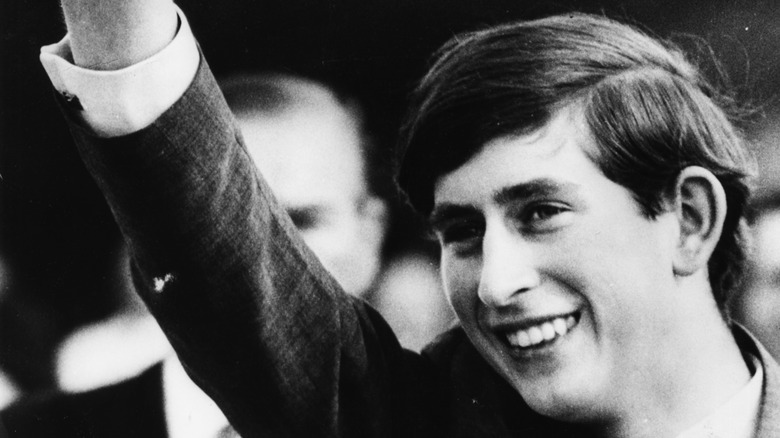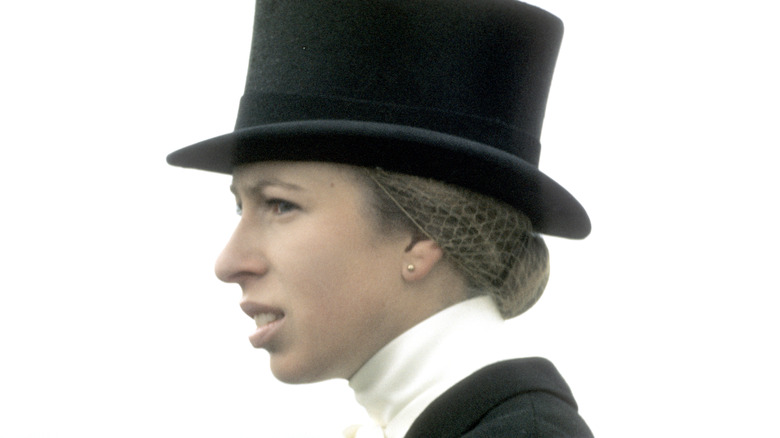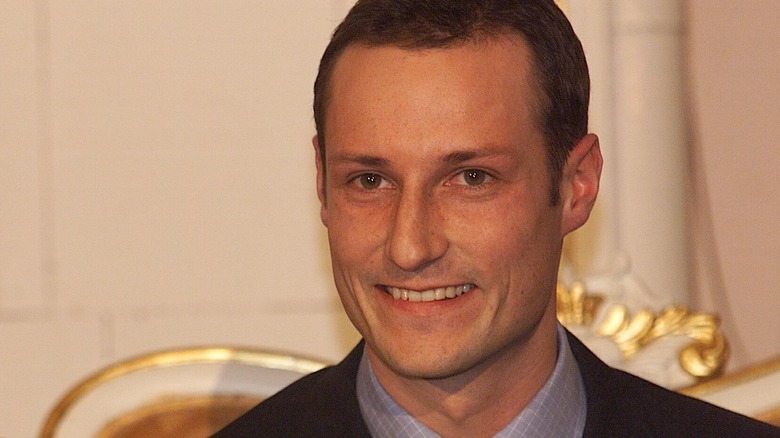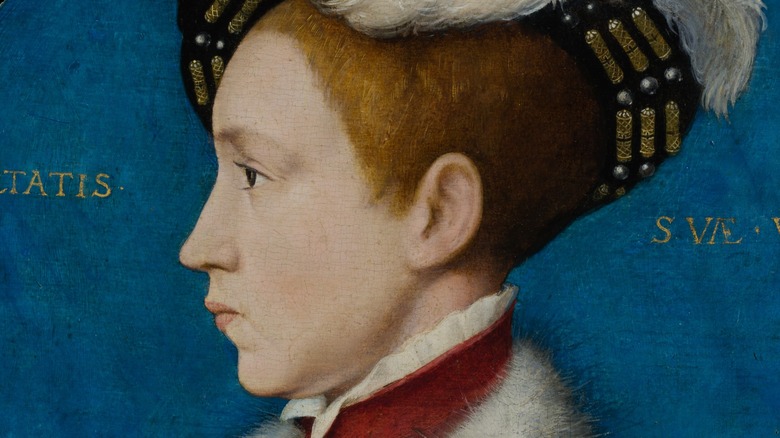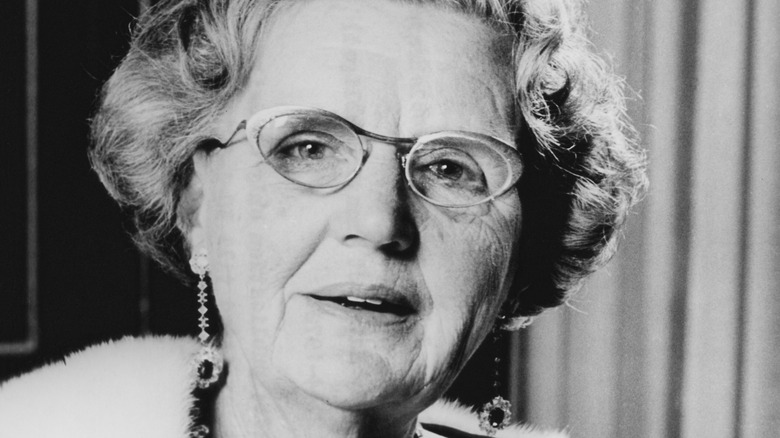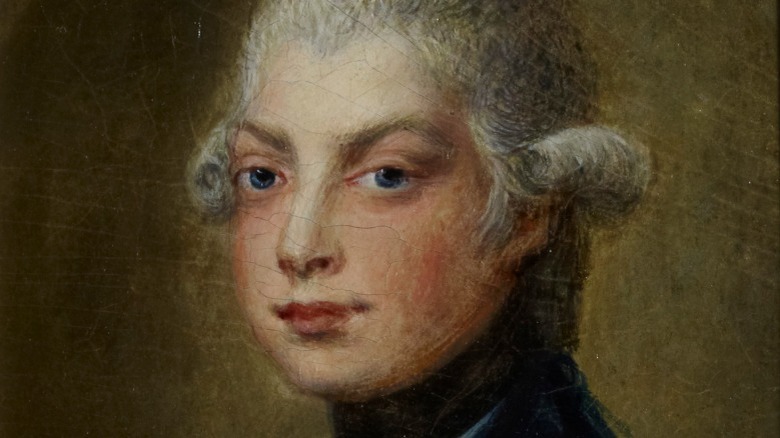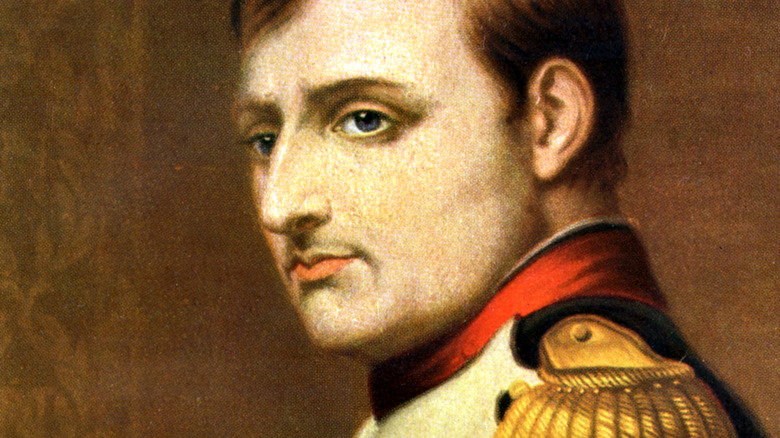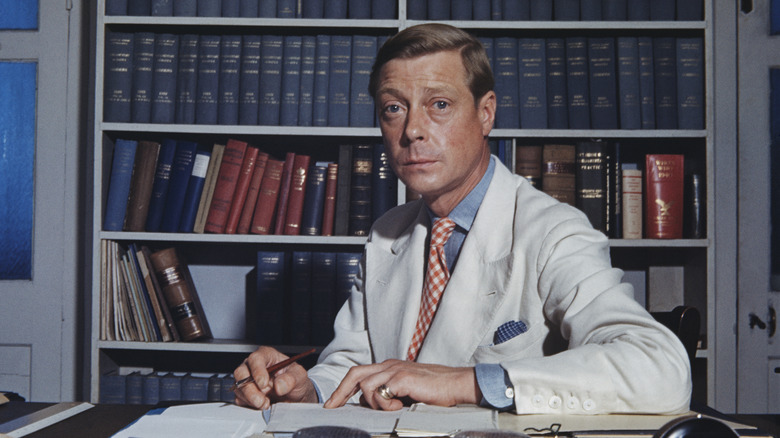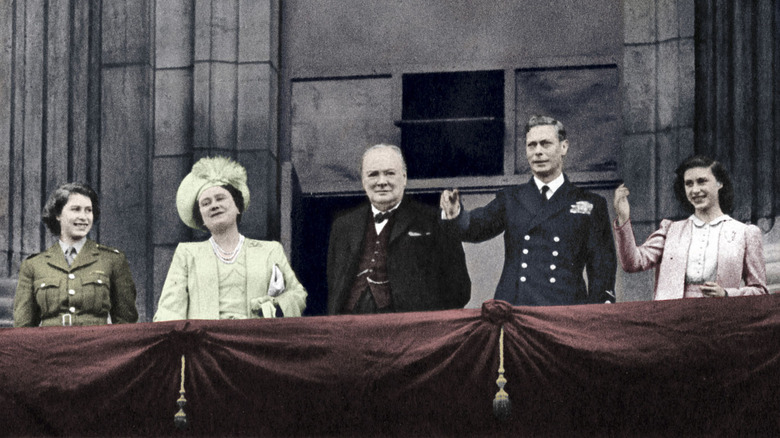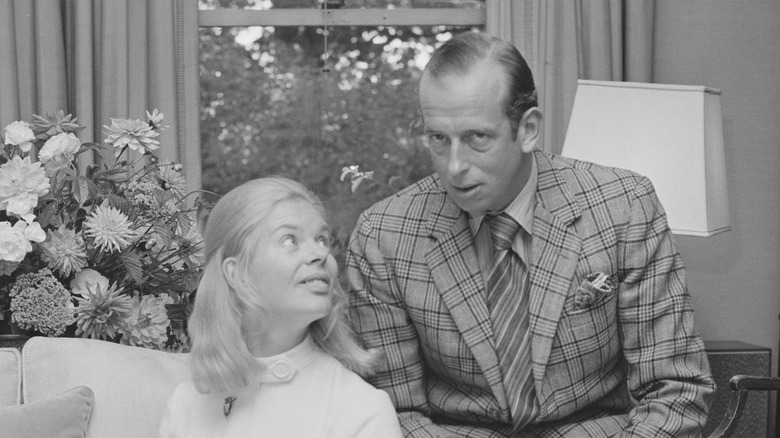Royals Who Were The Target Of Kidnapping Plots
Thanks to all the bodyguards who surround them pretty much constantly, it is very difficult to kidnap a royal. However, that does not mean that there are not people out there willing to give it a good try. Fortunately, these plans almost always come to nothing, and in many cases, no actual kidnapping attempt is ever made. However, that doesn't mean these situations aren't scary, or that there wasn't a chance the criminals involved might have pulled it off if something had gone differently.
The possibility of being kidnapped is taken very seriously by modern royals. According to Marie Claire, Meghan Markle underwent "princess training" before she married Prince Harry – and it included a very realistic kidnapping simulation. Members of the British special forces war-gamed a kidnapping with her, complete with live ammunition. The point was to make it as realistic as possible, with one expert noting, "Even though Meghan will have known the enemy was not real, I guarantee that she will have been petrified."
Of course, that fear is nothing compared to the very real terror royals must feel knowing that out there at any time are people who might try to abduct them. But who would even think of attempting it, and what would their motivation be? Here are some royals who were the target of kidnapping plots.
King Charles III
Back in the late 1960s, the then-Prince Charles was studying at Cambridge University in England. Sure, a college education wasn't necessary for his future job prospects, but it was nice that he gave it a go. Unfortunately, it was when he was at college that he "came within a hairsbreadth" of being kidnapped, according to his former bodyguard, Michael Varney. British tabloid The Daily Mail ran excerpts from the book "The Secret Royals: Spying and the Crown, from Victoria to Diana," and the authors took pains to emphasize how dangerous the situation was.
Since the prince wanted to enjoy himself at college, like any young person would, his security – while still a constant presence – was relaxed a bit. This left an opening that a group of very organized, very prepared, and very serious students from Manchester University planned to exploit.
While you'd assume women mobbing the still-single future king would always be an issue, in this case, they weren't looking to date him. The would-be-kidnappers were all women, who Varney claims were feminists and saw their kidnapping plot as a way to advance their cause, including their intention to kidnap the royal without "any male assistance whatsoever." While it might sound ridiculous, the book claims that they had a very detailed plan and were only foiled when the police got wind of it. Varney actually confronted one of the leaders – and, quite bizarrely, threatened to spank her if she followed through on the plan. The threat worked, though, and the kidnapping was called off.
Princess Catharina-Amalia
Royal kidnapping threats are definitely not a thing of the past. And while the British royal family might be the most well-known to most people, there are plenty of other royals out there who are under threat today as well. Case in point, Princess Catharina-Amalia, daughter of King Willem-Alexander and Queen Máxima of the Netherlands. While that country might have a very chill reputation due to its relaxed marijuana and sex work laws, the princess – who as the eldest child is heir to the throne – sadly discovered there are some criminal elements there that are not at all laid back.
In September 2022, the 18-year-old princess enrolled at the University of Amsterdam, and The New York Times reported she just wanted the same college experience that any other Dutch teenager would look forward to. Instead, within a month, she had to leave her dorm and effectively barricade herself back in a royal palace due to threats against her safety, including, according to The Telegraph, possible kidnapping attempts by organized and very dangerous criminal gangs.
Queen Máxima explained how much this affected her daughter. "It means that she doesn't live in Amsterdam and that she can't really go outside, and these consequences are very difficult for her," said at a press conference. "So for her, it's not the student life that other students have." The queen started crying as she said, "It's not nice to see your child not so happy. She can go to [classes], but that's it ... I think she is very brave."
Princess Anne
Queen Elizabeth II's daughter Princess Anne was a huge celebrity in 1974. According to Smithsonian Magazine, she'd just gotten married to Captain Mark Phillips, and a record-breaking 500 million people had tuned in to see them say "I do." But this fame also put a target on her back.
Ian Ball was a mentally unbalanced young man, and his kidnapping plot reflected this. Working on his own, he intended to kidnap the princess, at which point, his plans only got more ridiculous, including demands that a multi-million-pound ransom be paid in £5 notes, and that the queen herself get on a plane to Switzerland with the money. In short, none of that was ever going to happen, even if he did kidnap Anne.
However, Ball did prepare well in the weapons department, as he had multiple guns and the princess had limited protection. He stopped her car on the way back from an event, and the princess' lone bodyguard, Jim Beaton, got out to confront him. Within moments, Beaton was shot and his gun jammed, leaving them all sitting ducks. Beaton told The Times, "I had nothing ... There was no back-up vehicle. The training was non-existent; but then again, [we thought] nothing was going to happen."
Ball shot three other men who tried to help and he kept trying to convince Anne to get out of the car, a conversation she later said was "very irritating." When more police finally arrived, Ball ran away, before quickly being apprehended. Thankfully, all the men who were shot survived.
Crown Prince Haakon
The planned abduction of Norway's Crown Prince Haakon was an extremely convoluted saga. In 1999, according to Royal Central, the head of the Kosovo mafia, Princ Dobroshi, was incarcerated in Norway on heroin trafficking charges. Dobroshi clearly did not want to be there, considering he'd already escaped once two years before, and while on the run went so far as to surgically alter his appearance in the hopes of avoiding recapture. But the law caught up to him eventually. This time, Dobroshi had a different plan on how to get out of prison.
It would involve kidnapping the 26-year-old heir to Norway's throne, Crown Prince Haakon. Assuming the country's government would do anything to get back such a high-value target, Dobroshi would demand to be traded in a prisoner swap. Considering the abduction was planned by the Kosovo-Albanian mafia, there was a good chance they would have pulled it off, had police not stumbled on evidence of the plot unexpectedly.
However, there was still a problem. Beefing up security around the prince himself was easy, but he was dating a single mother named Mette-Marit Høiby. Mette-Marit and her young son were soft targets, and her home would be an ideal place for the prince to be kidnapped from, since it didn't have any special security. So the police basically insisted the couple speed their relationship up, and Mette-Marit and her son moved in to the prince's apartment at the palace. Fortunately, it all worked out, as the couple got married in 2001.
Edward VI
After Henry VIII's death in 1547, his 9-year-old son came to the throne as Edward VI. Since no one wants a pre-pubescent kid running a country, this meant he got a temporary mentor/guardian until he was old enough to rule on his own. According to History Extra, the role of "Lord Protector" was snatched up by Edward Seymour, whose younger brother Thomas Seymour would marry Henry VIII's widow Katherine Parr. If that all seems pretty confusing, all you really need to keep in mind is these two powerful brothers were playing out their sibling rivalry on a massive scale.
Thomas wanted to control the young king and oust his brother. He took any chance to do this, attempting to influence the boy and turn him against the lord protector. Finally, Thomas went one further and tried to kidnap the king. Not only that, but he also planned to force the teenage Princess Elizabeth (later Queen Elizabeth I) to marry him – Katherine Parr had died in childbirth by this point – so that he could set himself up to run the country one day.
The Tudor Society records that on January 16, 1549, someone snuck into the bedroom of the king in the middle of the night. While technically historians don't know who that person was with 100% certainty, both then and now it was assumed Thomas Seymour was the culprit. The would-be kidnapper was only frightened away when the king's dog started barking and brought people running. Thomas was arrested, tried, and executed for the crime.
Queen Juliana
The effects of the violent subjugation of foreign people and cultures by Western colonizers are still felt long after those countries gain their independence. While the Dutch might not be as famous for their extensive worldwide colonization as some countries, they were just as bad as anyone. And this would lead to many tragedies in the 1970s.
The New York Times reported, in a 1975 article, that Indonesia won independence from the Netherlands in 1950. But countries are not always composed of a single culture, and sometimes even after a colonizing country leaves, these factions do not get along. This was the case for a group called the South Moluccans, who were descended from enslaved Africans the Dutch brought to the islands centuries before. After independence, the group was in such danger from Indonesians that 12,000 of them fled to the Netherlands. The government there also promised that they would get their own country.
Of course, this never happened. As the feet dragging by the Dutch continued into the 1970s, young South Moluccans who had been born in Europe and were now reaching adulthood, decided to take matters into their own hands. Time reported that over the course of five years, South Moluccan terrorists murdered innocent civilians at the Indonesian consulate in Amsterdam and its embassy in The Hauge, and on a passenger train. In 1974, a group planned to kidnap Queen Juliana and other Dutch royals by breaking through a palace gate in an armored vehicle. Fortunately, the plot was thwarted.
King William IV
Many American colonists weren't the biggest fans of George III, so it's quite surprising that one of the king's children put himself in harm's way and came to America during the Revolutionary War. Then known as Prince William Henry, the future King William IV of England arrived in New York only about a month before General Lord Charles Cornwallis surrendered to General George Washington at Yorktown in October 1781. But, as author and Electoral College expert Tara Ross explains, even though the Brits had surrendered didn't mean everything immediately calmed down. It wouldn't be until 1783 that a treaty between the two countries was finally signed.
So, in 1782, when Prince William was still in New York, George Washington agreed that he should be kidnapped. He wrote to Matthias Ogden (via The National Archives), "The spirit of enterprise so conspicuous in your plan for surprising in their quarters, & bringing off the Prince-William Henry & Admiral Digby, merits applause; and you have my authority to make the attempt." Washington was quick to point out that the prince and the admiral should be treated nicely during their kidnapping, of course.
The Journal of the American Revolution records that the plan was highly detailed and well thought out. It's assumed Washington believed he could trade a kidnapped prince for lots of American captives, although the Journal points out that it also could have blown up in the general's face, and even restarted hostilities with England. It's impossible to know, since, in the end, the kidnapping attempt didn't happen.
Napoleon
Napoleon Bonaparte came to power in the disorder following the French Revolution. But it wasn't just his archenemies the British who weren't fans of Napoleon; there were plenty of his own countrymen who wanted to see him gone. This meant that Napoleon was the focus of assassination and kidnapping plots throughout his reign. According to Napoleonic Guide, sometimes kidnapping was Plan B if an assassination failed, like when one group failed to kill him in a way that is very reminiscent of the attempts made by the CIA to kill Fidel Castro: They tried to swap out his snuff box for one with poison in it. When they couldn't manage that, kidnapping him became their new plan, but that went nowhere as well.
But the most serious plot to kidnap Napoleon was in 1804. It even got a name – the Cadoudal Plot. Britannica records that the goal was to get the old French royal family on the throne – ideally, one of the ones that hadn't already lost their heads, one would think. While this plot was also foiled, PBS says it was no thanks to Napoleon's chief of police, Joseph Fouché, who somehow missed a lot of the threats against his boss. It makes you wonder, especially since within a few years, Fouché was openly plotting against Napoleon himself. But even for those who were convicted of being part of the kidnapping plot, Napoleon could be forgiving: Britannica says that he pardoned one of the conspirators, General Jean Moreau.
Edward VIII
Edward VIII famously abdicated the British throne in 1936, saying he couldn't go on being king if he wasn't allowed to marry the twice-divorced American Wallis Simpson. No one really knew what to do now that they had an ex-king hanging around, so his brother, the new king George VI, gave Edward the title Duke of Windsor and made him governor of the Bahamas. According to "Operation Willi: The Plot to Kidnap the Duke of Windsor, July 1940," it was on the way to his new job that the duke was targeted in a kidnapping plot.
There is a lot of controversy over just how much Edward liked Hitler, and no one's mind will be changed here. But Hitler definitely saw Edward as potentially useful to him, especially once his planned invasion of the United Kingdom succeeded. In fact, in their writeup about "Operation Willi," Publisher's Weekly notes that Hitler thought kidnapping the duke was so important, he even delayed his invasion attempt in the hopes he'd have Edward in his custody by then.
The duke was going to travel to the Bahamas in 1940 via Portugal. By then, the Nazis had taken over Spain. The plan was for the kidnappers to nip over the border, grab the duke, and offer to make him king of England again if he supported Hitler's invasion. Otherwise, he'd remain their captive. The plot made it to a very advanced stage, but in the end, it was the incompetence of the men tasked to carry it out that saved Edward from this fate.
George VI and his family
The English royal family knew they were in danger during World War II. Not only was Buckingham Palace bombed, but there was a very good chance Germany would successfully invade the U.K. and they would become targets of kidnapping or worse. And even though Elizabeth, the Queen Consort, famously released a statement promising, "The children will not leave unless I do. I shall not leave unless their father does, and the King will not leave the country in any circumstances, whatever" (via British Heritage), there were plans to at least get the royals to safety within England if the worst happened.
Hitler hoped that if he kidnapped the royal family, Britain would have no choice but to surrender. In his book "The King's Private Army: Protecting the British Royal Family During the Second World War," Andrew Stewart writes about the detailed plans of both Hitler to abduct the royals, and British security forces trying to stop him from succeeding.
Stewart told the tabloid The Daily Mail, "According to German sources, Hitler devised a plan for bombers to launch a dive-bomb attack on Central London. Then paratroopers, dropped from low-flying aircraft, would land in the grounds of Buckingham Palace and capture any members of the Royal Family they could find." But, he notes, they were under strict orders not to kill any of the royals, as this would mean Hitler's plan to use them as leverage would be ruined. The plan to protect the king, Operation Rocking Horse, was never needed, since Hitler's invasion of England failed.
Prince Edward, Duke of Kent
If you're a fan of tennis, you might know Prince Edward, Duke of Kent from the trophy presentation after the finals, since he was patron of Wimbledon for years. But other than that, the late Queen Elizabeth II's cousin isn't that well-known. That didn't stop him from being a target of an IRA plot in the 1970s, though.
During the period known as "The Troubles," the IRA employed terrorist bombings and assassinations with the aim of liberating Northern Ireland from the British. They also used kidnapping as a tactic, according to author Robert Hardman, speaking to The Telegraph.
When researching his book "Queen of Our Times: The Life of Elizabeth," Hardman discovered previously unseen documents that showed the government – and the queen – were aware of an IRA plot to kidnap Edward in 1971, when he was scheduled to go to Northern Ireland with his military unit. The queen was worried not just about her cousin, but how his presence as a target of the IRA could lead to innocent people around him getting killed or injured as well. In what was a very uncharacteristic move for the queen, she made her opinion known that maybe Edward shouldn't go to Northern Ireland at all, just to be safe. In response, a Ministry of Defense official promised, "The Queen's wish that the Duke should not be sent into Belfast has been carefully noted."

